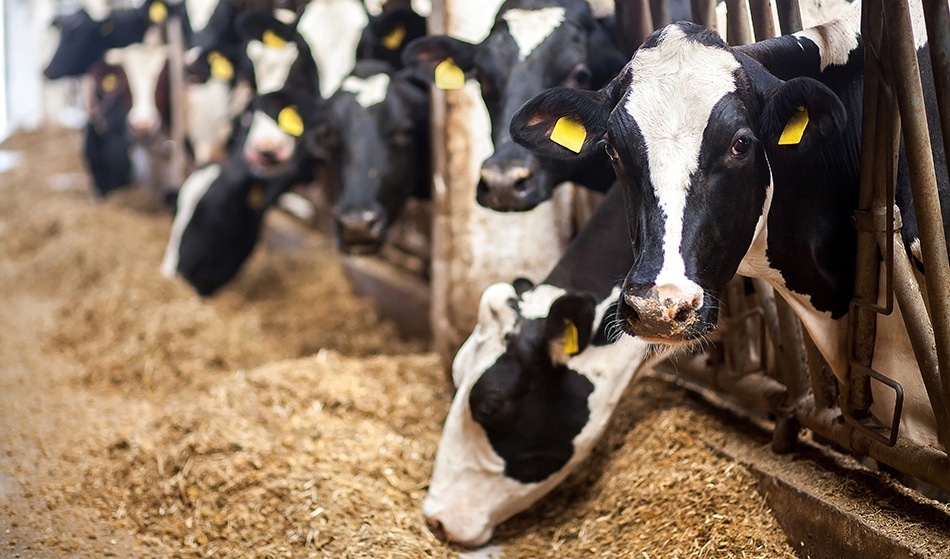By the year 2050, researchers estimate that the global population will reach 9.6 billion; a 33% increase that will take place in only 30 years. At the same time, the global demand for agricultural products is also expected to increase by a staggering 70%. In an effort to ensure food security for this growing population and simultaneously prevent damage that could occur as a result of climate change, it is critical to examine the environmental impacts of both the livestock and crop sectors.

Studio Peace/Shutterstock
The Impact of Livestock and Feed Production on Greenhouse Gas Emissions
Each year, livestock generates 14.5% of the total global anthropogenic greenhouse gas emissions. Of these emissions, livestock cultivation is responsible for a 29% increase in nitric oxide (N2O), a 27% increase in carbon dioxide (CO2) and a 44% increase in methane (CH4) emissions.
The increase in N2O emissions occurs as a result of livestock feed production, which has been associated with causing an increase in atmospheric nitrogen deposits, as well as the ability to alter the management of crop residues. Furthermore, the application, deposition and storage of manure plays a significant contributing role in emitting both N2O and CO2 into the atmosphere. The processing and transportation of both live animals and carcasses combined with the manufacturing, packaging and transportation of fertilizers used for animal feed has been shown to directly increase CO2 emissions. Additionally, land usage changes that have been made to accommodate livestock are also associated with increased CO2 emissions. The decomposition of manure is also a major factor that contributes to a rise in CH4 emissions.
Livestock Affects Land and Water Quality
As the single largest anthropogenic user of land in the world, livestock grazing occupies approximately 26% of land on Earth, whereas land dedicated to the production of livestock feed is estimated to occupy 30% of all land. In order to accommodate global livestock demands, many countries around the world, specifically those in Latin America, have resorted to deforestation of as much as 70% of previously forested land.
Livestock production also consumes more than 8% of global human water. As a result of these impressive water requirements, researchers have determined that a large percentage of water pollutants in fact originate from livestock-related substances. For example, the deposition of animal wastes into water supplies can propagate the spread of pathogenic and bacterial species that infect soils, vegetation, insects and fish.
Antibiotics and hormones, as well as numerous chemicals present in fertilizers, pesticides and tanneries, have been found to contaminate water through direct discharge, runoff or seepage into surface and groundwater sources.
Land Usage and Crop Cultivation
In addition to the cultivation of crops that are used to support livestock populations, various other cropping processes pose a direct threat to the natural properties of the land they occupy. For example, changes in the landscape and use of lands for cropping has been shown to dramatically promote a loss of biodiversity. The cultivation of crops has also consistently been associated with soil loss that occurs as a result of soil erosion and salinization in irrigated areas. For the soil that remains in these areas, dramatic changes in terms of its particle size, organic matter contact, fertility and water holding capacities are a common occurrence.
Conclusion
Although both the livestock and crop industries have already contributed to climate change, the global demand for these products is only expected to rise. The current practices of these industries have the potential to cause deleterious and irreversible environmental effects; therefore, the legislative entities in exporting nations are responsible for setting realistic standards that can prevent this damage from occurring. For example, the adoption of agricultural policies that emphasize environmental objectives, such as by imposing a limit on pesticide use, can have a dramatic impact on resolving the agriculture-nature conflict. Since the recent climate report by the United Nations has been published, which states that only 12 years remain to limit a climate change catastrophe from occurring, it is imperative that any and all practices that contribute to climate change end before it is too late.
References
- Rojas-Downing, M. M., Nejadhashemi, A. P., Harrigan, T., & Woznicki, S. A. (2017). Climate change and livestock: Impacts, adaptation and mitigation. Climate Risk Management 16; 145-163. DOI:10.1016/j.crm.2017.02.001.
- “Livestock Impacts on the Environment” – Food and Agriculture Organization of the United Nations
- “Potential Environmental Impacts of the Supply of Concentrate Feed Commodities” – Food and Agriculture Organization of the United Nations
- “Surface Water Pollution from Livestock Production” – Northeast Glacial Lakes Watershed Improvement and Protection Project
Disclaimer: The views expressed here are those of the author expressed in their private capacity and do not necessarily represent the views of AZoM.com Limited T/A AZoNetwork the owner and operator of this website. This disclaimer forms part of the Terms and conditions of use of this website.